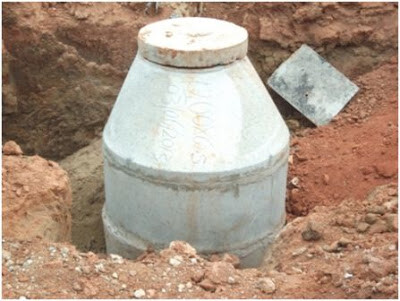A manhole (alternatively called utility hole, cable chamber, maintenance hole, inspection chamber, access chamber or confined space) is the top opening to an underground utility vault used as an access point for making connections or performing maintenance on underground and buried utility and other services including sewers, telephone, electricity, storm drains, and gas. The types of manholes that would be discussed in this article include sanitary sewer manholes and stormwater drain manholes.
Location of sewer manholes
Storm sewer manholes are usually provided at;
(a) Intersections of stormwater drains
(b) Junctions between different sizes of stormwater drains
(c) Where a stormwater drain changes direction/gradient
(d) On long straight lengths at the following intervals;
– For pipes with a diameter less than 600mm, provide manholes at a maximum interval of 40m
– For pipes with a diameter between 600mm – 1050mm, provide manholes at a maximum interval of 80m
– For pipes with a diameter greater than 1050mm, provide manholes at a maximum interval of 120m
In addition, manholes should wherever possible be positioned such that the disruption to the traffic will be at a minimum when their covers are lifted under normal maintenance operations.
Access opening of manholes
A manhole opening for man access should not be smaller than 550mm by 550mm. If cat ladders are installed in a manhole, the minimum clear opening should be 675mm by 675mm. A man access opening should be placed off the centreline of the stormwater drain for deep manholes, and along the centreline of the stormwater drain for shallow manholes with depths less than 1.2m.
Covers to manholes
Manhole covers should be sufficiently strong to take the live load of the heaviest vehicle likely to pass over, and should be durable under different weather conditions. Manhole covers should not rock when initially placed in position, or develop a rock with wear.
Step irons and cat ladders
Step-irons should be securely fixed in position in manholes, and should be equally spaced and staggered about a vertical line at 300mm centres. Cat ladders should be used in manholes deeper than 4.25m or where manholes are frequently entered. It is safer and easier to go down a ladder when carrying tools or equipment.
Forces acting on round manhole shafts
The forces acting on circular manhole shafts are;
– Lateral earth pressure
– Hydrostatic pressure
Because both loads are uniformly distributed around the periphery of the manhole, no bending moment is experienced by the manhole section. The following equation may be used to calculate the total lateral pressure at a given depth (H).
p = (Ws × H × Ks × Cosi) + (Ww × H)
Where;
p = total earth and hydrostatic pressure
Ws = Unit weight of backfill material
H = depth of manhole
Ks = coefficient of earth pressure
i = angle of internal friction of soil
Ww = unit weight of water
In theory, the pressure (P) acts equally around the periphery of the manhole section, placing the ring in pure compression without introducing bending moments into the concrete section in the horizontal plane. The compressive stress in any section of the round manhole riser is given by the equation;
S = pD/2t
Where;
S = compressive stress in the ring
p = total lateral earth and hydrostatic pressure
D = diameter of manhole
t = thickness of the manhole
















• Just wanted to let you know and say very great job on your blog. I for one agree with what you are saying and hope to see more of your posts in the near future.
BIM Consulting
BIM Solutions
BIM Implementation
Point Cloud to BIM conversion
Fabrication Drawings preparation